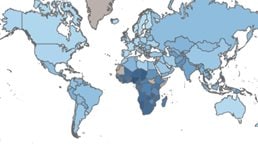The COVID-19 pandemic is an unwelcome reminder of just how much health matters for individuals, society, and the global economy. For the past century or more, health improvements from vaccines, antibiotics, sanitation, and nutrition, among others, have saved millions of lives and been a powerful catalyst for economic growth. Better health promotes economic growth by expanding the labor force and by boosting productivity while also delivering immense social benefits. However, in recent years, a focus on rising healthcare costs, especially in mature economies, has dominated the policy debate, whereas health as an investment for economic return has largely been absent from the discussion.
As the whole world reimagines public health and rebuilds its economy, we have a unique opportunity not merely to restore the past but to dramatically advance broad-based health and prosperity.
In Prioritizing health: A prescription for prosperity, we measure the potential to reduce the burden of disease globally through the application of proven interventions across the human lifespan over two decades. By intervention, we mean actions aimed at improving the health of an individual. These range from public sanitation programs to surgical procedures and adherence to medication and encompass interventions recommended by leading institutions like the World Health Organization or national medical associations. We also examine the potential to reduce the disease burden from innovations over the same period.
We then determine the impact the disease burden reduction could have on population health, the economy, and wider welfare over the period to 2040 (see sidebar, “Our research methodology”). We conduct our analysis for almost 200 countries; our global, regional, and income-level analyses are aggregated from the country-level analysis.
Throughout this report, we often use short hand to refer to the disease burden reduction potential as the healthy growth scenario. This scenario is an aspirational yet realistic assessment of the range of interventions that could lead to meaningful health improvement at the population level and boost long-term global economic growth.
Health as a catalyst for growth
Over the past century, improved hygiene, better nutrition, antibiotics, vaccines, and new technologies have contributed to tremendous progress in global health (Exhibit 1). Recent innovations have led to dramatic improvements in survival rates for people with certain types of cancer, heart disease, and stroke in many countries. Improvements in health have extended lives and improved quality of life, contributing to the rapid expansion of the labor force and labor productivity in the second half of the 20th century, which were key factors behind strong economic growth over that period. As countries grew richer, they invested in better food and safer environments, creating a virtuous cycle of improved health and higher incomes. Economists estimate that about one-third of economic growth in advanced economies in the past century could be attributed to improvements in the health of global populations. Research focused on more recent years has found that health contributed almost as much to income growth as education.

Despite the progress of the past century, in a typical year, poor health and health inequity continue to limit economic prosperity. This plays out in two ways. First, premature deaths limit growth by reducing the size of the potential labor force. Over 17 million people lost their lives prematurely in 2017. Second, poor health or morbidity makes it hard for those suffering from health conditions to be economically active and realize their full productive potential. For example, a total of 580 million person-years was lost to poor health among those aged 15 and 64 in 2017, leading them to be absent from work or quit employment altogether.
Overall, we estimate that the cost of ill health was more than $12 trillion in 2017, about 15 percent of global real GDP. Health shocks such as the COVID-19 pandemic, H1N1 influenza, and SARS can result in additional humanitarian and economic costs. The COVID-19 pandemic and its repercussions, such as the shelter in place measures to control the spread of the virus, are forecast to reduce global GDP by 3 to 8 percent in 2020.
Health has not typically been part of economic-growth discussions, especially in developed countries where the recent debate has primarily focused on the cost of healthcare. But a number of trends suggest that health may well matter more for growth in coming decades. First, improving health can counter the drag on growth that result from slowing population growth. Labor force growth globally is expected to slow from an annual rate of 1.8 percent over the past 50 years to 0.3 percent in the next 50 years. At the same time, the demand for highly skilled knowledge workers is increasing.
Improved health can help counter these longer-term headwinds by extending healthy lifespan for workers of prime working age and older, and by developing the physical and cognitive ability of children, the future labor force of the world. Second, health is no longer improving in all regions because obesity-related conditions and mental health challenges are burdening people of all ages, including those of prime working age. In addition, persistent and in many cases growing health inequity creates a gap in health outcomes between rich and poor within societies. Third, healthier populations are more resilient in the face of new infectious diseases, like COVID-19, that can often present higher risks to people with existing health conditions.
What would it take to improve the world’s health?
The Institute for Health Metrics and Evaluation (IHME), the institution that maintains the leading database on the global disease burden, projects that the global disease burden (measured in disability adjusted life years known as DALYs) will decline at a slower rate that in the past. This particularly applies to mature economies where the population is aging and faces more age and income-related health conditions as diabetes, cardiovascular disease, and some cancers. However, greater health gains are expected in low-income countries, many of which lag behind higher-income countries in life expectancy and other measures of health, mainly from preventable and treatable causes such as diarrhea and malaria, nutritional disorders, and poor child and maternal health (Exhibit 2).

We estimate that the global disease burden could be reduced by about 40 percent by applying known interventions in broader segments of populations and with closer adherence to the most effective tools available.
A reduction in the global disease burden of this magnitude would deliver significant health benefits. Child mortality could drop by 65 percent by 2040. Cancer deaths could decline by 29 percent, cardiovascular disease deaths by 39 percent, and neglected tropical diseases and malaria deaths by 62 percent. Overall, 230 million more people would be alive in 2040, half of them under the age of 70. For people at middle age, the shift could extend the number of years in good health by a decade, essentially making 65 the new 55. Every region in the world would experience an improvement in this range.
While we find that the overall potential to improve global health is substantial, known interventions vary widely in their capacity to battle specific diseases (Exhibit 3). Over 70 percent of the health gains could be achieved from prevention by creating cleaner and safer environments, encouraging healthier behaviors and addressing the social factors that lie behind these, as well as broadening access to vaccines and preventive medicine. The remaining 30 percent would come from treating disease and acute conditions with proven therapies including medication and surgery.

To identify interventions with the highest health benefit at the lowest cost we use cost curves. Over all, we find that over 40 percent of health improvements can be achieved at a net cost of less than $100 for every additional healthy life year. Because the costs of delivering better health vary widely, we estimate them separately for four country income archetypes. In low-income countries, we find the most cost-effective interventions (lowest incremental cost of reducing ill health by 1 DALY) include childhood immunizations, prevention and treatment of malaria, safe childbirth, better nutrition, and cardiovascular disease prevention.
In lower-middle-income countries, we find midwife-assisted safe childbirth could deliver 1 percent of the total addressable disease burden for 0.1 percent of the total additional costs. Treatment for malaria and TB, and prevention of cardiovascular disease with support and education for lifestyle change and pharmacological prevention are also very important. In upper-middle- and high-income countries, the greatest health improvement could come from increased use of preventive strategies for cardiovascular disease and diabetes including weight management, smoking cessation, and prevention and treatment of substance-use disorders and low back pain, which includes supported behavior change and weight management.
What role does innovation play?
Today’s interventions are the innovations of the past. Without them, healthy lifespans would not be as long as they are. Innovation continues to be critical to tackle diseases without a known cure as well as help us increase uptake and adherence to interventions we know work (about 60 percent of the remaining disease burden in our analysis). Leading the list of diseases without a known cure are mental health and neurological disorders, cardiovascular disease, and cancers. The good news is that innovations that completely change the lives of patients continue to emerge and prove the continuing power of innovation. One example is the nearly 70 percent reduction in premature death due to chronic myeloid leukemia in Switzerland from 1995 to 2017.
We identify ten promising innovations in progress that could have a material impact on health by 2040. We determined these technologies by focusing on areas with the greatest combination of unmet need, biological understanding of the disease pathway, and the effort and excitement surrounding each, measured by funding. While identifying and sizing the potential scope of innovations in the pipeline is inherently difficult, we estimate that these technologies have the potential to reduce the disease burden by a further 6 to 10 percent, assuming aspirational yet realistic adoption rates by 2040, on top of the 40 percent from known interventions.
Not only could some of these innovations be fully curative for some diseases, but by tackling the underlying biology of aging, they could significantly extend healthy lifespan by postponing the onset of several age-related conditions. This contrasts with innovations of the past 30 years, many of which reduced symptoms or delayed disease progression while prevention and cures were rare. Additionally, the innovations we have identified here are more digitally-enabled than in the past. As an example, artificial intelligence (AI) systems make advances in omics and molecular technologies, such as gene editing, faster and more accurate.
Realizing these innovations will require continual investment in research and development across pharmaceutical companies, medical and other technology companies, and academia.
How large is the economic prize?
The economic benefits from the health improvements we size are substantial enough to add $12 trillion or 8 percent to global GDP in 2040, that translates into 0.4 percent faster growth every year (Exhibit 4). These benefits arise through the labor market, both by expanding future employment through fewer early deaths, fewer health conditions, and higher labor-force participation of healthier people and through the productivity gains achievable by workers who are physically and cognitively healthier.

By 2040, 245 million more people could be employed. About 60 million of them would have avoided early death from cardiovascular disease, cancers, malaria, and other causes, adding $1.4 trillion to 2040 GDP. Addressing mental health disorders, diabetes, or other conditions would no longer be a barrier to joining the labor force for an equivalent of about 120 million full-time workers, contributing an additional $4.2 trillion. Another $4.1 trillion could be unlocked by expanding labor-force participation among three groups: older populations for whom better health can be an opportunity to work longer (about 40 million people), informal caregivers who no longer need to care for loved ones (12 million people), and people with disabilities who can go to work because workplaces adapted to accommodate their needs (eight million people).
Lastly, improving health could drive up productivity and lift GDP by as much as $2.0 trillion by reducing presenteeism from chronic conditions such as low back pain, but also through investing in childhood nutrition, which improves the cognitive and physical health of the future workforce. Just addressing adolescents’ mental and behavioral health issues, which affect about 60 million young people globally, could unlock $600 billion by 2040 through raising their educational attainment and earnings potential.

What will better health mean for people around the world?
The expansion of the labor supply in a healthy growth scenario could add 0.3 percent to global employment growth. One-fifth of the new labor-market entrants would be in high-income economies, where this expansion could fully counter the projected slowdown in labor-force growth. The rest, 80 percent, would improve health and increase the labor force in low- and middle-income countries.
While more challenging to value in dollars, we estimate the social benefits from improved health by applying the approach used in economics to measure welfare. We estimate the total combined value of deaths averted and reduced ill health could be approximately $100 trillion without adjustments for income levels—eight times the estimated GDP benefits. This number is so high because people typically value good health above everything else. Improving health could also help narrow health disparities within countries and across countries. This in turn could also contribute to reducing income inequality within countries and strengthen the social contract.
The best part is that focusing on known health improvements could deliver an incremental economic benefit of $2 to $4 for each $1 invested (Exhibit 5).

Realizing the benefits would mean shifting spending to prevention. Prevention of diseases is typically less expensive than treatment and reduces the need for more expensive treatment later on, contributing to a high economic return. Shifting incremental spending to prevention would not be simple, however, because it requires substantial changes in where and how healthcare is delivered, as well as changes to communities that would help individuals grow up, work, and age in healthy ways. It is important to note that our economic analysis should not be interpreted as calling for additional funding for healthcare as currently delivered, but as an alternative approach under which health needs are addressed early, with proven, effective, typically lower-cost approaches.
Realizing the healthy growth opportunity
Capturing the benefits that we identify in this report would require dramatic changes that extend beyond what we typically think of as healthcare. That means it would necessitate change by governments and regional authorities, companies, innovators, and communities to shape environments and societies in ways that promote healthy lives and capture the societal and economic benefits we size.
The COVID-19 pandemic provides a unique moment to engage governments, companies, and communities around the world in this endeavor. The pandemic has exposed deep vulnerabilities in healthcare systems, supply chains, and social structures, and vast inequities that need to be addressed.
As societies emerge from the immediate crisis, we can aspire to do more than plug gaps and hope for recovery. We can build a better healthcare system and a stronger, more resilient global economy that delivers better health for all and shared prosperity for decades to come. To help realize that opportunity, we identify four imperatives:
1. Make healthy growth a social and economic priority
Our analysis shows that investing in health can be a critical lever for future growth and an important part of the economic policy debate. Instead of thinking of health as a cost to society, focusing on health as an investment can deliver significant social and economic returns. Governments around the world have a lead role to play and should consider developing and delivering healthy life agendas including labor market and employment policies, that deliver both health and economic benefits.
2. Keep health on everyone’s agenda
The COVID-19 pandemic forced health onto the agenda of every organization and every household around the world. Keeping it there can deliver significant benefits. Long-term prevention and health promotion, which encompasses more than 70 percent of the benefits we identified, cannot simply be left to healthcare providers or healthcare systems. It is quite literally everybody’s business. Advancing healthy communities and healthy and inclusive workplaces will be critical.
3. Transform healthcare systems
The COVID-19 pandemic has exposed vulnerabilities in healthcare systems everywhere. Taking the opportunity to strengthen and reimagine systems may not only ensure better preparation for future crises but also deliver healthcare more effectively. The challenge is making and sustaining changes that shift to preventive health while ensuring resilience and flexibility. This will involve high-quality and holistic primary care and services that address behavioral and social health needs, like housing, deploying a broader range of delivery channels to reach people when and where they are most likely to benefit. The current incentives in many healthcare systems and organizations are not sufficient to ensure this transition and require a fundamental reassessment.
4. Double down on innovation
As the world awaits a vaccine or an effective treatment for COVID-19, the vital role that innovation plays for health and the global economy could not be more evident. Innovations will continue to be critical to improving the health of the world’s population. Today a little over a half of the $300 billion in global R&D spending on healthcare comes from the private sector. Promising innovations include genomics to deliver more targeted prevention and treatment; data science and AI to detect and monitor disease and enhance research; tech-enabled delivery to expand and reimagine access; and advances in the understanding of the biology of aging. However, realizing the full potential of the innovation pipeline may require shifting economic incentives to reward the areas with greatest need and highest return and building more collaborative approaches to R&D.
Realizing the healthy growth opportunity that we size in this report requires a coordinated effort by all stakeholders—governments, companies, and health institutions—to promote change within healthcare systems and beyond. But today, in the face of the COVID-19 pandemic, a unique opportunity to do just that has emerged. The benefits would be large: a $12 trillion economic opportunity, hundreds of millions of lives saved, and better health in the global population. Could there be a more important objective than making the world both healthier and more prosperous?



